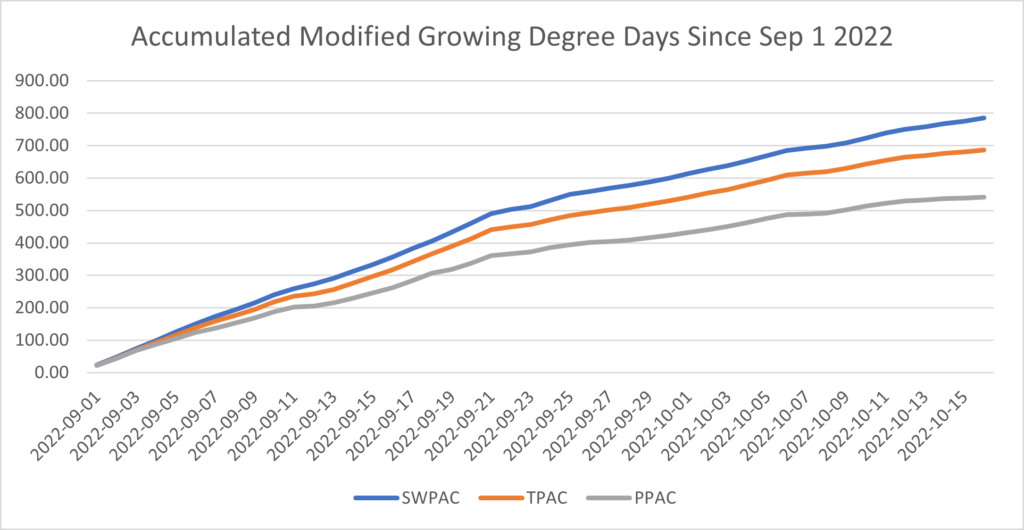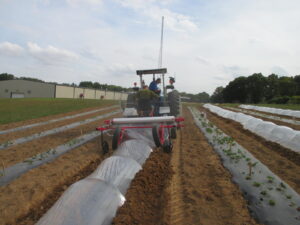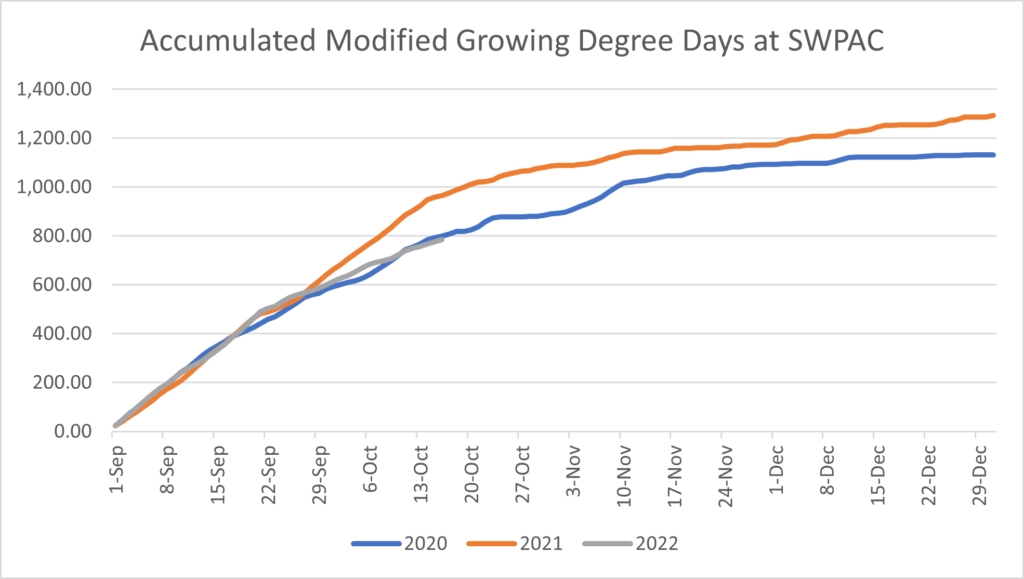5I have heard concerns about the size of strawberry plants this year. To provide a timely update of crop status, we created a blog site where there will be frequent updates of plasticulture strawberry status across Indiana. If you are interested in learning the current crop status, please visit this site https://www.purdue.edu/hla/sites/guan/blog/. We saw a large variation in plant sizes at different locations; production systems, weather conditions, cultivars, and other environmental and management factors likely to influence plant growth.
Growing degree day (GDD) is a good tool to understand temperature influence on plant growth at different locations and in different years. Using the modified growing degree day tool from Purdue Mesonet Data Hub, we compared the modified growing degree days from Sep 1 to Oct 17 in the past three years at Southwest Purdue Ag Center. The up-to-date accumulative GDD in 2022 was similar in 2020, but it was fewer than that in the same period in 2021 (Figure 1). We also compared accumulated GDD at three Purdue Ag Centers in Indiana, there was about a 200 GDD difference between southern and northern IN since Sep 1. 2022 (Figure 2).

Figure 2. Accumulated modified growing degree days at Southwest Purdue Ag Center (SWPAC, Vincennes IN), Throckmorton-Purdue Agricultural Center (TPAC, Lafayette, IN), and Pinney Purdue Ag Center (PPAC, Wanatah, IN) since Sep 1 2022.
Flower initiation happens in the crown. Crown size at the end of fall largely determines spring yield potential. Crown growth and development is best at temperatures above 50°F. As temperatures may drop quickly, do additional environmental protection increase plant growth? At SWAPC, we have observed the plant size differences of strawberries grown inside the high tunnel and grown in the open field. The additional accumulated GDD provided by high tunnels has led to faster plant growth.
For open-field production, low tunnel or row covers may be used to increase growth.
We explored using low tunnels to extend the fall growth in the past few years. We installed the low tunnels using a mechanical transplanter low tunnel layer in early Oct. The low tunnel layer set hoops 4.5’ apart and covered with 1 mil perforated clear plastic. Low tunnel plastic was removed in Dec before covering the plants with a floating row cover. We explored the system for three strawberry seasons (Figure 3). In the 2019-20 season, a significant yield increase was achieved with low tunnels, but the yield of the best cultivars was under 1 lb/plant even using low tunnels. Deer damage happened in September before installing low tunnels delayed plant growth. This article describes that story. We did not see a yield increase using low tunnels in the 2020-21 and 2021-22 seasons. In both seasons, plugs were planted at the end of Aug. and fall was relatively warm. Most plants’ yields were above 1 lb/plant; satisfied yields were achieved without using low tunnels.

Figure 3. Low tunnel was installed with a mechanical transplanter low tunnel layer.
A few critical factors farmers should consider in using the additional protection in the fall. First, both low tunnel or floating row covers increased temperature fluctuations and delayed the process of plant acclimatization. As a result, plants may be more susceptible to winter damage if unseasonably cold temperatures happen while plants are still actively growing (see the above article for more information). Second, using additional protection, mainly row covers, increases relative humidity. High relative humidity plus warm temperatures increase disease potential. A study in North Carolina found more gray mold fruit on plants covered with row covers in the fall. The study suggested a strict spray program must be implemented to minimize disease losses if row covers were used. Third, a thinner row cover that allows better light transmission should be considered if one chooses to use row covers in the fall.
In short, additional protection can increase plant growth, but one should balance the extra cost, increased risks of other factors, with a potential yield increase when deciding on using additional protection to encourage fall growth in plasticulture strawberries.
This project is supported by North Central Region Sustainable Agriculture Research and Education program under project number LNC21-454.
